More than 300,000 privately owned ponds have been constructed across Missouri to serve a variety of purposes. When properly managed, they can add value to a property (Figure 1). However, ponds are complex ecosystems that require the owner's commitment to ensure they remain productive. Knowledge of a few basic ecological concepts is important whether you are managing a pond for aquaculture enterprise or for recreational activities such as sport fishing.
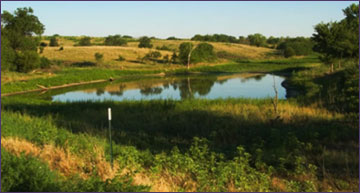 Figure 1
Figure 1
Private ponds provide recreational opportunities and amenities such as wildlife habitat, sport fishing, irrigation and livestock watering.
Basics of pond ecology
Small farm ponds and lakes are not natural environments because they are man-made. Considerations for successful pond management include maintaining food availability for fish, harvesting fish to maintain a balance of predator and prey populations, managing aquatic vegetation, and preventing situations that may cause fish kills. If recreational fishing is your goal, you should also consider water quality, the pond food chain and other factors that affect aquatic life.
Plankton
Small organisms suspended in a pond comprise the basis of the aquatic food chain and produce other life-supporting essentials, such as dissolved oxygen (Figure 2). Fish and other aquatic animals need oxygen to survive, but it is not freely available in pond water and must be dissolved into the water either directly from the air or indirectly through photosynthesis, the process by which plants absorb carbon dioxide and produce simple sugars and oxygen. Aquatic plants — primarily phytoplankton and other algae — release oxygen directly into the water as a byproduct of photosynthesis.
Plankton are commonly classified as phytoplankton (plants) and zooplankton (animals). Phytoplankton are at the bottom of the aquatic food chain and are eaten by zooplankton, bacteria and other small organisms. Small fish feed on zooplankton soon after hatching and will not survive if this food source is not readily available. Phytoplankton and zooplankton populations are essential for producing a healthy community of fish in a pond or lake (Figure 3).
Plankton populations, suspended sediments and organic matter can affect the color and clarity of pond water. Productive water — that is, water that will support dense fish populations — tends to have a green tint, which is produced by chlorophyll pigments in phytoplankton. Although phytoplankton are the basis of a healthy pond, larger populations can become a management problem.
Dense populations of phytoplankton are referred to as blooms. These blooms can die off or "crash" rapidly, which causes the water to appear dark or black as the dead phytoplankton decay and decompose. The process of decay uses oxygen and therefore may reduce oxygen levels enough that fish begin to die. Phytoplankton blooms flourish when large amounts of nutrients, such as from livestock manure or fertilizers, enter the pond from the surrounding watershed.
As with phytoplankton, sediments (silt and soil) washed into the pond after heavy rains can change pond color and affect water quality. Normal color should return within a few days as these particles settle. How quickly suspended particles settle depends on certain water quality parameters. They will take much longer to settle in ponds with soft water and alkalinity levels below 50 parts per million (ppm). Ponds with too much suspended sediment can become unproductive and endanger aquatic life in several ways:
- Murky water resulting from suspended sediment reduces the amount of sunlight available to plants for photosynthesis and oxygen production.
- Fish gills can become clogged with sediment particles, making it difficult for fish to breathe.
- Particles may damage fish gill surfaces, increasing the likelihood of infections.
- An increase in sediment ultimately reduces the volume of water within the pond and can lead to many problems, but ultimately requires engineering and dredging to remove.
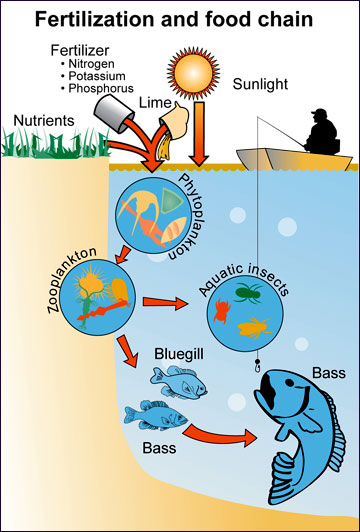 Figure 2
Figure 2
Depiction of a simple food chain in a pond.
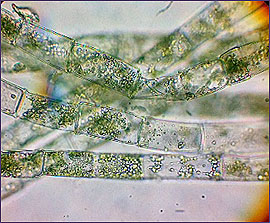
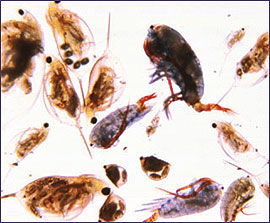 Figure 3
Figure 3
A diversity of phytoplankton (left) and zooplankton (right) species indicates that the pond has a good population of various sizes of plankton available as a food source.
Water quality
Factors such as pH, which indicates whether the water is acidic or basic; alkalinity; dissolved oxygen; and several other parameters can affect pond water quality and fish populations (Table 1).
The concentration of dissolved oxygen in a pond will change over a 24-hour period. Dissolved oxygen will typically increase during the day as a result of plants completing the process of photosynthesis. Photosynthesis does not occur at night, so dissolved oxygen levels decline. In addition, aquatic organisms continue to respire through the night, using available oxygen and producing carbon dioxide.
Large populations of phytoplankton can cause large fluctuations in oxygen and pH levels. During the summer, large populations of phytoplankton elevate oxygen levels during the day through the process of photosynthesis.
Photosynthesis is vital to the production of oxygen in a pond to support aquatic life. Because photosynthesis is driven by sunlight, no oxygen is produced at night. Oxygen levels decline as plants and animals consume oxygen to breathe (respiration). In a well-managed pond, nighttime dissolved oxygen levels should not fall below 5 ppm. Oxygen levels below 3 ppm distress fish, and many species may be at risk of dying when oxygen levels fall below 2 ppm.
Pond water pH varies over the course of a day as a result of respiration and photosynthesis. Pond pH normally fluctuates between 6.5 and 9. If the pH drops below 5 or rises above 10, the likelihood of a fish kill increases. Consider buying a water quality test kit to measure variables and identify any potential problems.
Alkalinity, the capacity to neutralize acid, of pond water is one of the most important water quality factors to consider. Alkalinity levels do not dramatically change from day to day but will fluctuate over weeks and months depending on the pH of soils in the pond and surrounding watershed.
Proper alkalinity levels improve pond dynamics by serving as a buffering agent and preventing drastic fluctuations in pond water pH. Bases react with acids to minimize fluctuations in pH. Alkalinity stabilizes both the water pH and phytoplankton populations, which serve to reduce major changes in the availability of dissolved oxygen. Alkalinity can also increase the availability of carbon dioxide and other nutrients to phytoplankton.
Ponds with alkalinity levels below 50 ppm are often difficult to manage and less productive. Ponds built in areas with plentiful limestone or dolomite may have alkalinity levels of 200 ppm or higher. These ponds will have stable pH values between 7.5 and 9.0 and are likely to be productive. To increase alkalinity levels, directly lime either the water, the pond basin or the soils in the nearby watershed. A soil test can determine the pH of the soil, which will dictate how much, if any, lime will be necessary. Refer to the MU Soil Testing Laboratory website (extension.missouri.edu/programs/soil-and-plant-testing-laboratory/spl-soil-analysis) for information on collecting soil and water samples.
Table 1
Acceptable water quality parameters for sport fish in ponds at recommended stocking rates.
| Parameter | Acceptable range |
|---|---|
| Dissolved gases | |
| Oxygen | No less than 5.0 ppm |
| Nitrogen | Less than 100% saturation |
| Free carbon dioxide | Less than 20 ppm |
| pH | 7.0–9.0 |
| Total dissolved solids | 100–400 ppm |
| Alkalinity | 50–300 ppm |
| Hardness | 100–300 ppm |
| Ammonia | |
| Total as N | 2–4 ppm |
| Un-ionized | Less than 0.02 ppm |
| Chlorine, residual | No more than 0.0003 ppm or no detectable amount |
| Nitrogen as nitrite | Up to 100 ppm |
| Iron (Fe) | No higher than 0.05 ppm |
ppm=parts per million
Understanding pond stratification
Water quality is also affected by annual processes occurring within the pond. One such process is thermal stratification. A thermally stratified pond has noticeable temperature zones as the water gets deeper. Stratification occurs because the density of water changes with temperature (Figure 4). Water is densest at 39 degrees F and is less dense at warmer temperatures. Water rises as it becomes less dense.
Many ponds in Missouri undergo thermal stratification at various times during the year, generally beginning in May or early June and ending in September or early October. The effect of stratification is profound on ponds and lakes and can affect various water quality parameters important for fish populations. Pond depth will affect the extent to which thermal stratification occurs. Shallow ponds — less than 6 to 8 feet deep — may not have stratification, because moderate winds tend to keep the pond circulating. Deeper ponds of at least 10 to 12 feet will almost always stratify.
In the early spring, winds blowing across the pond will cause water to move downward and across the pond bottom toward the upwind side, so the entire pond circulates and maintains a uniform water temperature (Figure 5). This process is commonly known as the "spring overturn." As weather warms in spring, surface water temperature also rises, causing the initial thermal stratification (Figure 6).
During summer, the temperature differential increases between the warm upper layer, the epilimnion, and the colder bottom layer, the hypolimnion. The thermocline is the thin layer of water between these two layers. There is a rapid decrease in water temperature below this level. Weather and wind conditions common during the summer often cannot cause these two layers to mix, so the pond remains stratified until the cooler temperatures of the fall (Figure 7).
As summer progresses into fall, water temperatures in the warmer, upper layer will gradually begin to cool. Thermal stratification ceases over time as water temperatures between the upper and lower layers become about the same. This process is referred to as the "fall turnover" (Figure 8).
As fall progresses into winter, water begins to cool and the colder upper layer becomes less dense. However, during the winter, the coldest water is near the surface rather than at the bottom. If a layer of ice forms, the pond will be shielded from the wind, preserving stratification until the ice melts (Figure 9).
Weather patterns will also affect pond stratification. High temperatures in summer months will cause most ponds to stratify. Heavy rainfall can deposit large amounts of cold water onto the top layer of warm water, possibly causing the pond to prematurely turn over and circulate low-oxygen water throughout the pond, which can lead to summer fish kills. Prevent these situations by aerating for continuous water circulation and more constant water temperatures. Larger bodies of water are more likely to be deeper and thus more likely to undergo stratification. However, because of increased surface area, larger ponds and lakes are less prone to problems associated with stratification.
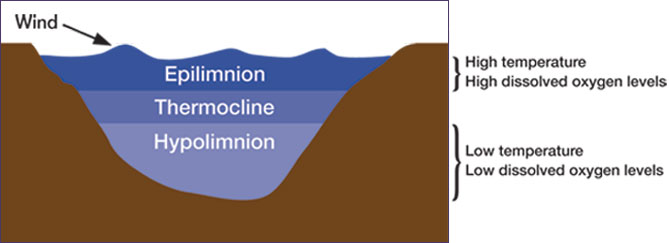
Figure 4
The thermal layers of a pond with strong stratificiation in the summer.
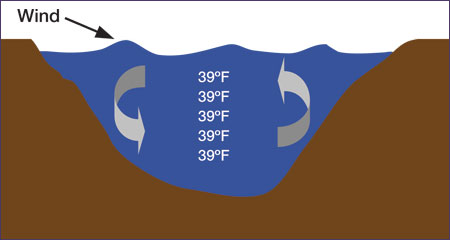 Figure 5
Figure 5
Pond circulation without thermal stratification in early spring.
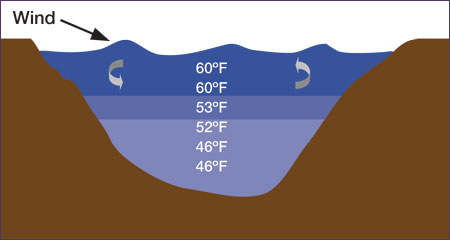 Figure 6
Figure 6
Pond circulation experiencing thermal stratification in late spring.
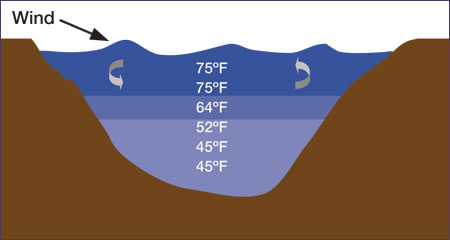 Figure 7
Figure 7
Strong stratification during summer.
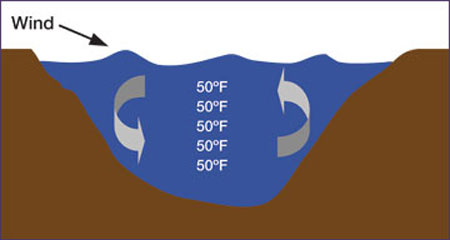 Figure 8
Figure 8
Water temperatures stabilize in the fall, due to water turnover.
 Figure 9
Figure 9
Thermal stratification during winter.
Preventing unexpected fish kills
Fish kills can occur in ponds at any time of year, but are most common during summer or winter months. They are primarily caused by water quality problems resulting from low oxygen levels or pond turnover.
Summer fish kills
Low oxygen levels in ponds will usually occur during the summer months — June through September — when water temperatures are highest. Several factors can contribute to low oxygen levels and fish kills in the summer:
- Dense phytoplankton blooms or dense stands of aquatic plants
- Cloudy weather over a period of several consecutive days reduces plant oxygen production
- High temperatures decrease the solubility of oxygen in water and increase oxygen use by aquatic plants and animals
- Sudden die-off of aquatic plants or algae in the pond, often associated with increased herbicide use
- Unusual weather patterns, such as storms that drop an abundance of cold rain on top of the warmer pond surface water, mixing the two layers and lowering oxygen levels
- Overstocking a pond with fish and feeding them at extremely high rates
- Excessively fertilized or nutrient-rich watershed
Observe your pond on a regular basis during the summer months for warning signs of a possible fish kill. Fish gulping for air at the surface just after sunrise is an early symptom of low levels of dissolved oxygen. A common way to increase dissolved oxygen levels is to use a commercial surface aerator — a pump and a nozzle that sprays water into the air. Any technique that mixes water and air can help provide an oxygen refuge for fish. However, supplemental aeration is only a remedy for low dissolved oxygen levels, so other factors causing the problem should be addressed.
Refrain from supplemental feeding of fish during extremely warm weather. Fish will often go "off feed" when water temperatures are around 85 to 90 degrees F, so most of the uneaten feed will sink to the bottom and decompose. The decomposition process can further decrease the amount of available oxygen in the pond.
Winter fish kills
Low oxygen levels can also occur in ponds during winter, particularly when snowfall prevents sunlight from reaching aquatic plants. Sunlight can penetrate several inches of ice, but snow can block most sunlight. As plants die and decompose, dissolved oxygen falls to levels that are potentially lethal to fish.
Prevent winter fish kills by keeping a portion of the ice covering your pond free of snow. This will expose aquatic plants to more sunlight. This practice is particularly important in shallow ponds with large areas that are less than 6 to 8 feet deep. Create openings that are about 10 square feet in size in numerous areas of the pond. Ice should generally be at least 4 inches thick it's safe to walk on, so make sure ice is safe before walking on it.
Refer to MU Extension publication G9402, Collection and Submission of Samples for Fish-Kill Investigation and Toxic-Substance Analysis, for additional information. This guide outlines steps for maintaining pond water quality and the process for submitting fish samples for disease diagnosis if an infectious disease is suspected of causing a fish kill.
Fish populations
The productivity of a pond or lake can be measured by its ability to support a population of fish, or its "carrying capacity." The fish carrying capacity of a pond can be defined as the total pounds of all species of fish the pond will support without negatively affecting productivity or the available food supply. This relationship is often expressed as pounds of fish per acre of water. A productive pond in Missouri can yield about 150 to 175 pounds of fish per acre each year.
Several factors contribute to a productive pond: proper location, design, construction, adequate fertility levels, proper selection of fish for stocking, and proper management of the pond and surrounding watershed.
Assuming your pond has been designed, constructed and properly placed within a watershed, proper management practices and tools can help ensure your pond will be productive and be able to meet your goals and objectives.
Proper fish species selection and stocking rates are necessary considerations. Bluegill and channel catfish fingerlings are usually stocked in the fall, and fingerling largemouth bass are stocked the next spring. The fish population will grow rapidly during the first summer, and breeding typically adds numerous bluegill and bass. During the second summer, the pond may reach its carrying capacity, so growth and reproduction will decrease unless some fish die or are harvested. The second summer is the best time to develop a record keeping system to keep track of the number and approximate size of each fish harvested. The first harvest will usually be the originally stocked fish because they will be large enough at that point to catch and remove or release. Take care during the first harvest to avoid removing all fish from the original stocking. Bass longer than 14 inches may be kept, but return bass smaller than 14 inches to ensure the availability of catchable fish next year.
Properly managed ponds in Missouri can generally yield, per acre, about 100 pounds of bluegill and about 30 pounds of largemouth bass. Count every channel catfish removed, because they will not reproduce to supplement the original population. Channel catfish fingerlings will need to be restocked periodically, but they should be larger than the biggest largemouth bass to ensure they are not eaten. A logbook is an effective tool for estimating the yield of the pond over time and will provide you with a record of catfish removed so you will know when they need to be restocked. Also, remember to inform people fishing your pond of the importance of keeping records so the pond can be properly managed.
Refer to the Missouri Department of Conservation's Missouri Pond Handbook and MU Extension publication G9474, Pond Construction and Management Considerations, for more detailed information on stocking and managing your pond for good fishing.
Conclusion
An understanding of the various factors that affect pond dynamics and water quality relationships is key to a healthy pond ecosystem. The success of your pond will depend on understanding these relationships and adopting management practices that maintain a productive environment for a sustainable and balanced fish population. Keep these practices in mind to ensure that your pond will remain productive and healthy:
- Stock the correct species and numbers of fish.
- Stock at the appropriate time of year.
- Manage for an adequate harvest, water quality and aquatic plants.
For more information on constructing, stocking and managing a pond, see the resources listed below or contact the Missouri Department of Conservation or your local MU Extension center.
Additional information
Missouri Department of Conservation publications:
- Missouri Pond Handbook
https://mdc.mo.gov/sites/default/files/2020-05/MOPondHandbook.pdf - Pond improvement series of guides
https://mdc.mo.gov/your-property/improve-your-property/habitat-management/pond-stream-management
MU Extension and Lincoln University fisheries and aquaculture publications: https://extension.missouri.edu/fisheries
- The Lakes of Missouri volunteer program and newsletter
http://www.lmvp.org - USDA Southern Regional Aquaculture Center publication series
http://srac.msstate.edu/publications.html